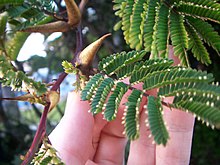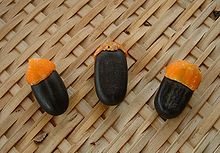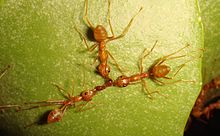Myrmecophyte: Difference between revisions
m →References: Journal cites, added 1 DOI, using AWB (8087) |
m Journal cites, templated 1 journal cites, using AWB (8087) |
||
| Line 1: | Line 1: | ||
[[File:Pseudomyrmex ferruginea Ryan Somma.jpg|Acacia ants|right|thumb]] |
[[File:Pseudomyrmex ferruginea Ryan Somma.jpg|Acacia ants|right|thumb]] |
||
'''Myrmecophyte''' (mər′mek•ə‚fīt; literally |
'''Myrmecophyte''' (mər′mek•ə‚fīt; literally "ant-plant") is a [[plant]] that lives in a [[Mutualism (biology)|mutualistic]] association with a colony of [[ant]]s. There are over 100 different genera of myrmecophytes.<ref name="Speight-2008">{{harvnb|Speight|Hunter|Watt|2008}}</ref> These plants possess structural [[adaptations]] that provide ants with food and/or shelter. These specialized structures include [[#Domatia|domatia]], [[#Food bodies|food bodies]], and [[#Extrafloral nectaries|extrafloral nectaries]].<ref name="Speight-2008" /> In exchange for food and shelter, ants aid the myrmecophyte in [[pollination]], [[seed dispersal]], gathering of essential [[nutrients]], and/or defense.<ref name="Speight-2008" /> Specifically, domatia adapted to ants may be called myrmecodomatia.<ref name="Wilson-1971">{{harvnb|Wilson|1971}}</ref> |
||
== Mutualism == |
== Mutualism == |
||
| Line 18: | Line 18: | ||
[[Domatia]] are internal plant structures that appear to be specifically adapted for habitation by ants.<ref name="Janzen-1966" /> These cavities are found primarily in the [[plant stem|stems]], [[leaves]], and [[spine (botany)|spines]] of plants. Many different genera of plants offer domatia. Plants of the ''[[Acacia]]'' genus have some of the most widely recognized forms of domatia and offer some of the best examples of ant-plant obligate mutualism.<ref name="Janzen-1966">{{harvnb|Janzen|1966}}</ref> Different species of ''Acacia'' provide a variety of resources needed for their codependent counterparts. One of these resources is the need for shelter. ''Acacia'' have enlarged [[thorn (botany)|thorns]] on their stems that are excavated by ants for use as housing structures.<ref name="Janzen-1966" /> Since the tree contains their nest, these aggressive ants react strongly to any disturbance of the tree, providing the myrmecophyte with defense from grazing [[herbivores]] and encroaching [[vine]]s.<ref name="Janzen-1966" /> |
[[Domatia]] are internal plant structures that appear to be specifically adapted for habitation by ants.<ref name="Janzen-1966" /> These cavities are found primarily in the [[plant stem|stems]], [[leaves]], and [[spine (botany)|spines]] of plants. Many different genera of plants offer domatia. Plants of the ''[[Acacia]]'' genus have some of the most widely recognized forms of domatia and offer some of the best examples of ant-plant obligate mutualism.<ref name="Janzen-1966">{{harvnb|Janzen|1966}}</ref> Different species of ''Acacia'' provide a variety of resources needed for their codependent counterparts. One of these resources is the need for shelter. ''Acacia'' have enlarged [[thorn (botany)|thorns]] on their stems that are excavated by ants for use as housing structures.<ref name="Janzen-1966" /> Since the tree contains their nest, these aggressive ants react strongly to any disturbance of the tree, providing the myrmecophyte with defense from grazing [[herbivores]] and encroaching [[vine]]s.<ref name="Janzen-1966" /> |
||
Domatia can also be found within the [[tubers]] of certain plants.<ref name="Jebb-1991">{{harvnb|Jebb|1991}}</ref> Tubers form when the [[hypocotyl]]s of a seedling swells to form a hollow, chambered structure that can become inhabited by ants.<ref name="Jebb-1991" /> The [[Rubiaceae]] family of plants contains the most commonly known tuberous myrmecophyte, ''[[Myrmecodia]]'', literally meaning |
Domatia can also be found within the [[tubers]] of certain plants.<ref name="Jebb-1991">{{harvnb|Jebb|1991}}</ref> Tubers form when the [[hypocotyl]]s of a seedling swells to form a hollow, chambered structure that can become inhabited by ants.<ref name="Jebb-1991" /> The [[Rubiaceae]] family of plants contains the most commonly known tuberous myrmecophyte, ''[[Myrmecodia]]'', literally meaning "ant-house".<ref name="Jebb-1991" /> |
||
[[File:A-cornigera.jpg|Enlarged thorns and beltian bodies on ''Acacia''.|right|thumb]] |
[[File:A-cornigera.jpg|Enlarged thorns and beltian bodies on ''Acacia''.|right|thumb]] |
||
| Line 58: | Line 58: | ||
===Ants and seed dispersal=== |
===Ants and seed dispersal=== |
||
{{Main|myrmecochory}} |
{{Main|myrmecochory}} |
||
[[Myrmecochory]], literally translated as |
[[Myrmecochory]], literally translated as "ant-dispersal," is the collection and dispersal of [[seeds]] by ants. Ants disperse more than 30% of the spring-flowering [[herbaceous plants]] in eastern [[North America]].<ref name="RicoGray-1991" /> Both the plant and the ant benefit in this scenario. The ants are provided with an [[elaiosome]], a detachable food body found on the surface of the seed. Elaiosomes have diverse compositions, usually high in [[lipids]] and [[fatty acids]], but also containing [[amino acids]], [[sugars]], and [[protein]].<ref name="RicoGray-1991" /> The ants remove the elaiosome once the seed has been transported to the [[ant colony|colony]]. As a result, the seeds are safely placed in nutrient-rich substrate protected from [[predator]]s, benefiting the plant with optimum establishment conditions for its seed.<ref name="RicoGray-1991" /> |
||
===Ants feeding plants=== |
===Ants feeding plants=== |
||
[[Myrmecotrophy]], meaning |
[[Myrmecotrophy]], meaning "ant-fed," is the ability of plants to absorb [[nutrients]] from debris piles left by ant nests or, in the case of ''[[Nepenthes bicalcarata]]'', from ant egesta.<ref name=Bazile>{{cite journal | last1 = Bazile | first1 = V. | last2 = Moran | first2 = J.A. | last3 = Moguédec | first3 = G. Le | last4 = Marshall | first4 = D.J. | last5 = Gaume | first5 = L. | year = 2012 | title = A carnivorous plant fed by its ant symbiont: a unique multi-faceted nutritional mutualism | url = | journal = PLoS ONE | volume = 7 | issue = 5| page = e36179 | doi = 10.1371/journal.pone.0036179 }}</ref> The tropical tree ''[[Cecropia]] peltata'' obtains 98% of its nitrogen from the waste deposited by its ant counterparts.<ref name="Benzing-1991">{{harvnb|Benzing|1991}}</ref> |
||
[[File:WeaverAntsAgainstRedAnt.JPG|Ants collaborating to dismember an intruding ant.|left|thumb]] |
[[File:WeaverAntsAgainstRedAnt.JPG|Ants collaborating to dismember an intruding ant.|left|thumb]] |
||
Revision as of 17:40, 18 July 2012

Myrmecophyte (mər′mek•ə‚fīt; literally "ant-plant") is a plant that lives in a mutualistic association with a colony of ants. There are over 100 different genera of myrmecophytes.[1] These plants possess structural adaptations that provide ants with food and/or shelter. These specialized structures include domatia, food bodies, and extrafloral nectaries.[1] In exchange for food and shelter, ants aid the myrmecophyte in pollination, seed dispersal, gathering of essential nutrients, and/or defense.[1] Specifically, domatia adapted to ants may be called myrmecodomatia.[2]
Mutualism
Myrmecophytes share a mutualistic relationship with ants, benefiting both the plants and ants. This association may be either facultative or obligate.[3]
Obligate mutualism
In obligate mutualisms, both of the organisms involved are interdependent; they cannot survive on their own. An example of this type of mutualism can be found in the Macaranga genus of plants. All species of this genus provide food for ants in various forms, but only the obligate species produce domatia.[1] Some of the most common species of myrmecophytic Macaranga interact with ants in the Crematogaster genus. C. borneensis have been found to be completely dependent on its partner plant, not being able to survive without the provided nesting spaces and food bodies. In laboratory tests, the worker ants did not survive away from the plants, and in their natural habitat they were never found anywhere else.[4]
Facultative mutualism
Facultative mutualism is a type of relationship where the survival of both parties (plant and ants, in this instance), is not dependent upon the interaction. Both organisms can survive without the other species. Facultative mutualisms most often occur in plants that have extrafloral nectaries but no other specialized structures for the ants.[3] These non-exclusive nectaries allow a variety of animal species to interact with the plant.[3] Facultative relationships can also develop between non-native plant and ant species, where co-evolution has not occurred. For example, Old World legumes that were introduced to North America can be protected by ants that originated from a different region.[3]
Structural adaptations of myrmecophytes

Domatia
Domatia are internal plant structures that appear to be specifically adapted for habitation by ants.[5] These cavities are found primarily in the stems, leaves, and spines of plants. Many different genera of plants offer domatia. Plants of the Acacia genus have some of the most widely recognized forms of domatia and offer some of the best examples of ant-plant obligate mutualism.[5] Different species of Acacia provide a variety of resources needed for their codependent counterparts. One of these resources is the need for shelter. Acacia have enlarged thorns on their stems that are excavated by ants for use as housing structures.[5] Since the tree contains their nest, these aggressive ants react strongly to any disturbance of the tree, providing the myrmecophyte with defense from grazing herbivores and encroaching vines.[5]
Domatia can also be found within the tubers of certain plants.[6] Tubers form when the hypocotyls of a seedling swells to form a hollow, chambered structure that can become inhabited by ants.[6] The Rubiaceae family of plants contains the most commonly known tuberous myrmecophyte, Myrmecodia, literally meaning "ant-house".[6]

Food bodies
Some plants produce food bodies for use by other organisms. These small epidermal structures contain a variety of nutrients that are removed and consumed by foragers.[7] Food bodies are identified by the main nutrient they contain and by the genus of plant producing them.[7] Beltian bodies are found on the leaflet tips of Acacia plants and have relatively high protein content[8] . Beccarian bodies are found on young leaves of the Macaranga genus and are especially rich in lipids. Lipids are also the main nutrient found in Pearl bodies, found on the leaves and stems of Ochroma plants. Most ant inhabitantsof Cecropia plants harvest the last type of food body, as their primary food source. Remarkably these Müllerian bodies, found on the stalk of the leaf, are primarily glycogen. Glycogen is the principal storage carbohydrate found in animals and is extremely rare in plants.[7]
| Beltian bodies | Protein | Acacia | Leaflet tips |
| Beccarian bodies | Lipids | Macaranga | Young leaves |
| Pearl bodies | Lipids | Ochroma | Leaves and stems |
| Müllerian bodies | Glycogen | Cecropia | Petiole of the leaf |

Extrafloral nectaries
Extrafloral nectaries are sugar-producing glands found outside the flower structures of plants. They occur in many different plant species around the world and are most commonly associated with vegetative structures that normally do not have nectaries, such as leaves, stems, and twigs.[3] These secreting structures are often non-exclusive in that nectar can be taken by a variety of animals; however, in some obligate myrmecophyte plants such as Acacia collinsii, extrafloral nectar is modified to be attractive only to the ant partners in the symbiosis.[3][9][10] The nectar thus provided feeds ants, which in turn protect these myrmecophytes from herbivorous activity. A species of deciduous tree that displays extrafloral nectaries, Catalpa speciosa, shows a decreased loss of leaf tissue on branches protected by ants, and an increase in number of seeds produced.[3]
Types of ant-plant interactions
Ants as pollinators
Unlike their bee relatives, ants rarely pollinate plants. Various assumptions have been made as to why ants are poor pollinators, although none have been verified: a) ants do not fly limiting their transport of pollen far enough to effect cross-pollination, b) ants do not systematically forage like bees do, and c) ants are not hairy, and clean themselves too frequently to allow pollen to be carried to other plants.[11] In most cases of ant pollination, the ants are one of multiple pollinators; meaning that the plants are not completely dependent on ants for pollination. However the orchid, Leporella fimbriata can only be pollinated by its winged male ant partner.[12]

Ants and seed dispersal
Myrmecochory, literally translated as "ant-dispersal," is the collection and dispersal of seeds by ants. Ants disperse more than 30% of the spring-flowering herbaceous plants in eastern North America.[7] Both the plant and the ant benefit in this scenario. The ants are provided with an elaiosome, a detachable food body found on the surface of the seed. Elaiosomes have diverse compositions, usually high in lipids and fatty acids, but also containing amino acids, sugars, and protein.[7] The ants remove the elaiosome once the seed has been transported to the colony. As a result, the seeds are safely placed in nutrient-rich substrate protected from predators, benefiting the plant with optimum establishment conditions for its seed.[7]
Ants feeding plants
Myrmecotrophy, meaning "ant-fed," is the ability of plants to absorb nutrients from debris piles left by ant nests or, in the case of Nepenthes bicalcarata, from ant egesta.[13] The tropical tree Cecropia peltata obtains 98% of its nitrogen from the waste deposited by its ant counterparts.[14]

Ants as defense
Since plants provide essential resources for ants, the need to protect the plant and those resources is extremely important. Many myrmecophytes are defended from both herbivores and other competing plants by their ant counterparts.[7] Acacia cornigera, for example, is thoroughly guarded by its obligate ant partner, Pseudomyrmex ferruginea. A single colony of P. ferruginea may contain more than 30,000 ants, and can tend multiple Acacia trees.[7] The soldier ants are extremely aggressive, patrolling the trees twenty-four hours a day. Any disturbance to the tree alerts ants, who then recruit more workers from inside the horn domatia. These ants defend the Acacia by biting, violently stinging, and pruning any trespassers. The ants keep the plant free from other insects and vertebrate herbivores, but also from invading fungi and other plants.[7]
See also
Notes
- ^ a b c d Speight, Hunter & Watt 2008
- ^ Wilson 1971
- ^ a b c d e f g Koptur 1991
- ^ Fiala, Maschwitz & Pong 1991
- ^ a b c d Janzen 1966
- ^ a b c Jebb 1991
- ^ a b c d e f g h i Rico-Gray & Oliveira 2007
- ^ Heil, M (2004). "Main nutrient compounds in food bodies of Mexican Acacia ant-plants". Chemoecology. 14 (1): 45–52.
{{cite journal}}: Unknown parameter|coauthors=ignored (|author=suggested) (help); Unknown parameter|month=ignored (help) - ^ Heil, M. (2005). Science. 308 (5721): 560–563 . http://www.jstor.org/stable/3841308 . Retrieved 04/11/2011.
{{cite journal}}: Check|url=value (help); Check date values in:|accessdate=(help); Missing or empty|title=(help); Unknown parameter|coauthors=ignored (|author=suggested) (help); Unknown parameter|month=ignored (help) - ^ Gonzalez-Teuber, Marcia (2009). "The Role of Extrafloral Nectar Amino Acids for the Preferences of Facultative and Obligate Ant Mutualists". Journal of Chemical Ecology. 35 (4): 459–468.
{{cite journal}}:|access-date=requires|url=(help); Check date values in:|accessdate=(help); Unknown parameter|coauthors=ignored (|author=suggested) (help); Unknown parameter|month=ignored (help) - ^ Beattie & Hughes 2002
- ^ Peakall, Handel & Beattie 1991
- ^ Bazile, V.; Moran, J.A.; Moguédec, G. Le; Marshall, D.J.; Gaume, L. (2012). "A carnivorous plant fed by its ant symbiont: a unique multi-faceted nutritional mutualism". PLoS ONE. 7 (5): e36179. doi:10.1371/journal.pone.0036179.
{{cite journal}}: CS1 maint: unflagged free DOI (link) - ^ Benzing 1991
References
- Beattie, Andrew J.; Hughes, Lesley (2002). "Ant-plant interactions". In Pellmyr, Olle (ed.). Plant-Animal Interactions. Malden, MA: Blackwell Publishing. pp. 211–235.
{{cite book}}: Invalid|ref=harv(help) - Benzing, David H. (1991). "Myrmecotrophy: origins, operation, and importance". In Huxley, Camilla R.; Cutler, David F. (eds.). Ant-Plant Interactions. New York, NY: Oxford University Press. pp. 353–373. ISBN 0-19-854639-4.
{{cite book}}: Invalid|ref=harv(help) - Fiala, Brigitte; Maschwitz, Ulrich; Pong, Tho Yow (1991). "The association between Macaranga trees and ants in South-east Asia". In Huxley, Camilla R.; Cutler, David F. (eds.). Ant-Plant Interactions. New York, NY: Oxford University Press. pp. 263–270. ISBN 0-19-854639-4.
{{cite book}}: Invalid|ref=harv(help) - Gonzalez-Teuber, M.; Heil, M. (2009). "The Role of Extrafloral Nectar Amino Acids for the Preferences of Facultative and Obligate Ant Mutualists". Journal of Chemical Ecology. 35: 459–468.
{{cite journal}}: Invalid|ref=harv(help) - Heil, M.; Baumann, B.; Kruger, R.; Linsenmair, K.E. (2004). "Main nutrient compounds in food bodies of Mexican Acacia ant-plants". Chemoecology. 14: 45–52.
{{cite journal}}: Invalid|ref=harv(help) - Heil, M.; Rattke, J.; Boland, W. (2005). "Postsecretory hydrolysis of nectar sucrose and specialization in ant/plant mutualism". Science. 308: 560–563.
{{cite journal}}: Invalid|ref=harv(help) - Janzen, D. H. (1966). "Coevolution of mutualism between ants and acacias in Central America". Evolution. 20: 249–275. doi:10.2307/2406628.
{{cite journal}}: Invalid|ref=harv(help) - Jebb, Matthew (1991). Huxley, Camilla R.; Cutler, David F. (eds.). "Ant-Plant Interactions". New York, NY: Oxford University Press: 374–389. ISBN 0-19-854639-4.
{{cite journal}}:|chapter=ignored (help); Cite journal requires|journal=(help); Invalid|ref=harv(help) - Koptur, Suzanne (1991). "Extrafloral nectarines of herbs and trees: modeling the interaction with ants and parasitoids". In Huxley, Camilla R.; Cutler, David F. (eds.). Ant-Plant Interactions. New York, NY: Oxford University Press. pp. 213–230. ISBN 0-19-854639-4.
{{cite book}}: Invalid|ref=harv(help) - Peakall, Rod; Handel, Steven N.; Beattie, Andrew J. (1991). "The evidence for and importance of ant pollination". In Huxley, Camilla R.; Cutler, David F. (eds.). Ant-Plant Interactions. New York, NY: Oxford University Press. pp. 421–429. ISBN 0-19-854639-4.
{{cite book}}: Invalid|ref=harv(help) - Rico-Gray, Victor; Oliveira, Paulo S (2007). The Ecology and Evolution of Ant-Plant Interactions. Chicago, IL: University of Chicago Press. pp. 42–51, 101–109.
{{cite book}}: Invalid|ref=harv(help) - Speight, Martin R.; Hunter, Mark D.; Watt, Allan D. (2008). Ecology of Insects (2nd ed.). West Sussex, UK: Wiley Blackwell Publications. pp. 212–216.
{{cite book}}: Invalid|ref=harv(help) - Wilson, Edward O. (1971). The Insect Societies. Belknap Press. ISBN 978-0-674-45490-3.
{{cite book}}: Invalid|ref=harv(help)
